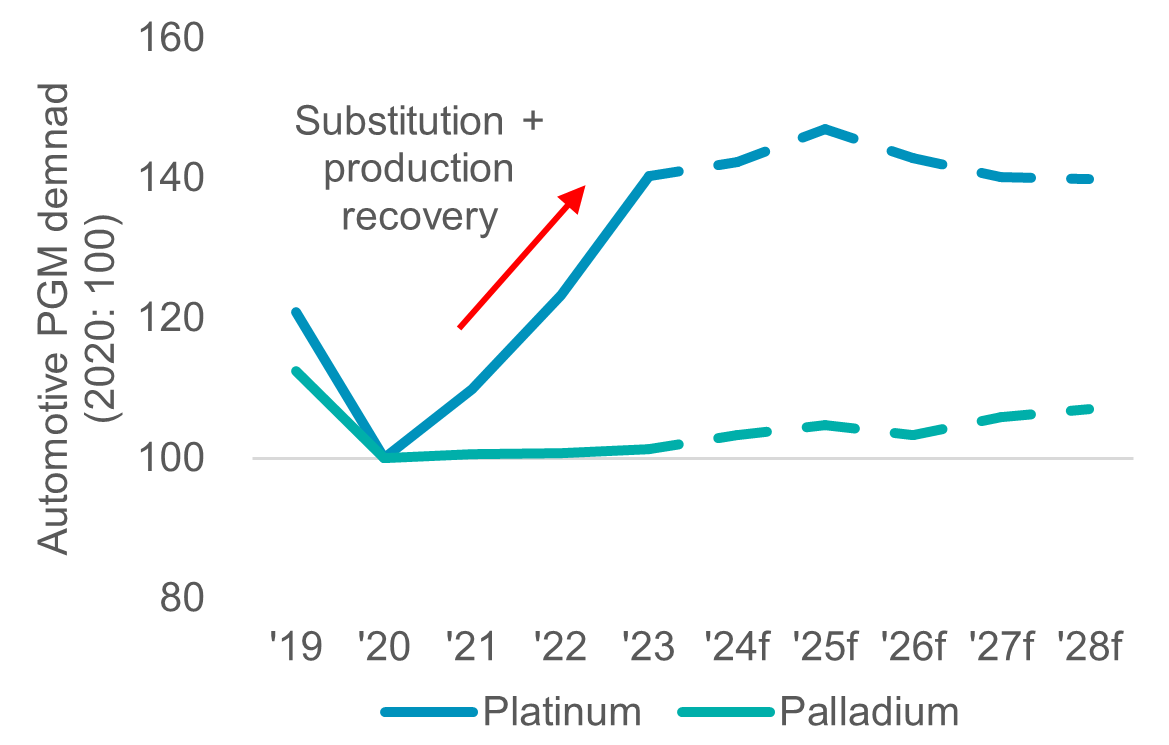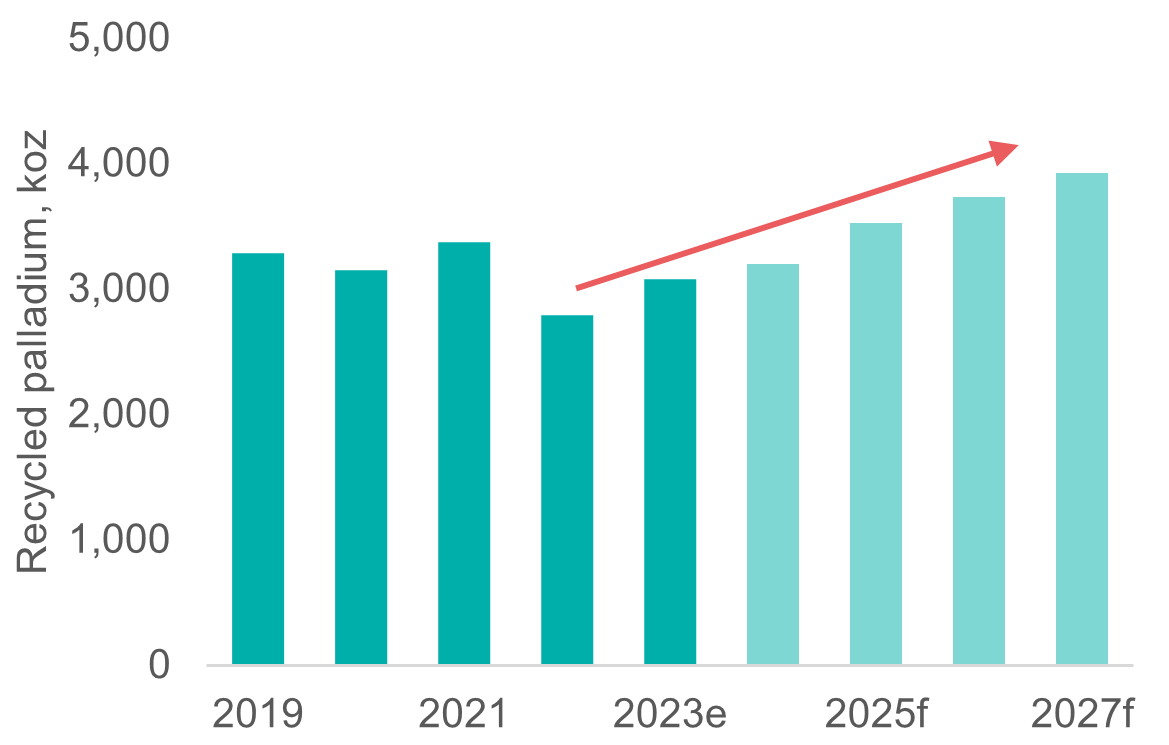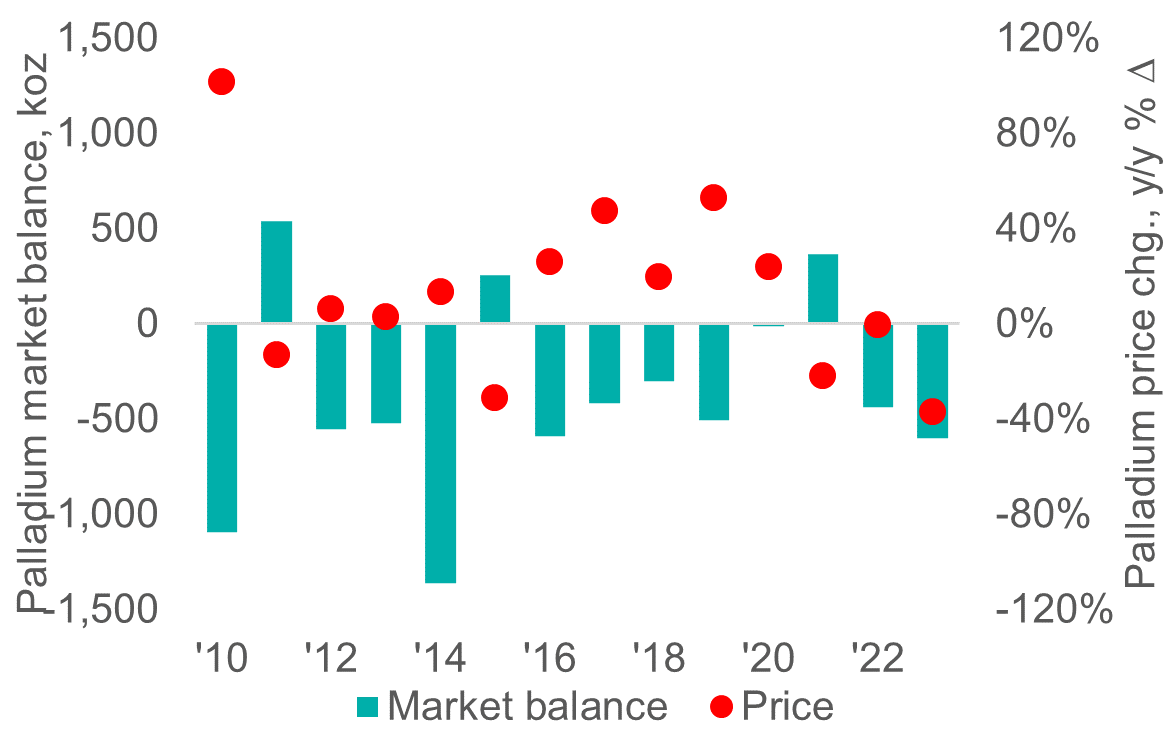Platinum for palladium substitution is embedded into automotive demand and unlikely to reverse swiftly
24 January 2024
Platinum for palladium autocatalyst substitution is expected to reach 700 koz in 2024f, up from 620 koz in 2023f. Our analysis shows that there are no economic incentives and a number of risks to reversing this process. Furthermore, the process of reverse substitution will be slow, even if it does occur. Thus, existing substitution is largely embedded in annual automotive demand for the medium term.
Platinum and palladium can be substituted on an almost 1:1 basis in autocatalysis. Simple economics led initial substitution in gasoline vehicles; palladium market deficits underpinned price increases resulting in platinum prices trading at a significant discount to palladium since 2017. The impact of substitution on annual platinum demand takes time since it almost exclusively only occurs on new vehicle models, representing around 15% of the market in any given year. Once substitution occurs, it is typically locked in for the vehicle platform’s life of around seven years because of the cost and risk to substitute on a vehicle platform already in production. Thus, reverse substitution will likely be slow to take effect (Fig. 1).
But the palladium market does not appear immediately conducive to reverse substitution. Although palladium’s price premium to platinum has narrowed (Fig. 2) and markets are expected to enter surplus from 2025f (Fig. 8), substitution’s economic incentive is unfavourable since palladium remains at a premium to platinum. Furthermore, several risks to palladium markets may caution automaker procurement teams from starting to substitute palladium for platinum. Firstly, palladium’s transition to market surpluses is largely based on a ~1 Moz increase in recycling supply (Fig. 4). Recycled PGM supply has been lower than expected due to lifestyle and affordability trends extending vehicle lives (link). This could delay palladium moving into surplus.
Fig 1. Automotive substitution still favours platinum
_222009.png)
Fig 2. Palladium converged toward platinum in 2023
_796535.png)
Secondly, substituting palladium for platinum increases exposure to Russia (11% of global Pt supply, 40% of Pd, Fig. 5), which may not be desirable on ESG grounds or due to sanctions and supply chain risks.
Finally, it is also easy to overlook the risks associated with the depletion of above ground palladium stocks which fell by 5.2 Moz since 2010 due to eleven annual periods of market deficits. In all but 2022 and 2023, palladium market deficits have correlated to price increases (Fig. 6). WPIC expects palladium market deficts in 2024f which historically suggests price support that would disincentivise substitution. Moreover, the combination of low physical stocks, supply risks and a build-up of short positions of the metal bias price risk to the upside; in December 2023, palladium prices increased US$240 in a week, indicative of a squeeze. Given market conditions without clear economic or supply incentives, it appears too soon to consider reversing platinum for palladium substitution. Our base case assumption is for gradual substitution from 2026f if indeed the palladium market does enter a surplus in 2025f.
Platinum’s attraction as an investment asset arises from:
- WPIC research indicates the platinum market entering a period of consecutive deficits from 2023
- Platinum supply remains challenged, both from primary mining and secondary recycling
- Automotive platinum demand growth should continue into 2024f due principally to substitution of platinum for palladium in gasoline vehicles
- Platinum is a critical mineral in the global energy transition underpinning a key role in the hydrogen economy
- The platinum price remains historically undervalued and significantly below both gold and palladium
Figure 3: After COVID platinum automotive demand growth exceeded palladium due to substitution

Figure 4: Recycled palladium supply is expected to increase by around 1 Moz to 2027f

Figure 5: Primary palladium supply is exposed to Russia where smelter maintenance is slated for 2024 and sanctions may suppress output

Figure 6: Barring 2023, palladium price changes have been inversely correlated to market balances since 2010

Figure 7: Financial markets have built significant net short positions on palladium, likely on expectations of market balances trending to surpluses

Figure 8: Palladium markets will remain in deficit during 2024, continuing a decades long trend on drawing down above ground stocks

IMPORTANT NOTICE AND DISCLAIMER: This publication is general and solely for educational purposes. The publisher, The World Platinum Investment Council, has been formed by the world’s leading platinum producers to develop the market for platinum investment demand. Its mission is to stimulate investor demand for physical platinum through both actionable insights and targeted development: providing investors with the information to support informed decisions regarding platinum; working with financial institutions and market participants to develop products and channels that investors need.
This publication is not, and should not be construed to be, an offer to sell or a solicitation of an offer to buy any security. With this publication, the publisher does not intend to transmit any order for, arrange for, advise on, act as agent in relation to, or otherwise facilitate any transaction involving securities or commodities regardless of whether such are otherwise referenced in it. This publication is not intended to provide tax, legal, or investment advice and nothing in it should be construed as a recommendation to buy, sell, or hold any investment or security or to engage in any investment strategy or transaction. The publisher is not, and does not purport to be, a broker-dealer, a registered investment advisor, or otherwise registered under the laws of the United States or the United Kingdom, including under the Financial Services and Markets Act 2000 or Senior Managers and Certifications Regime or by the Financial Conduct Authority.
This publication is not, and should not be construed to be, personalized investment advice directed to or appropriate for any particular investor. Any investment should be made only after consulting a professional investment advisor. You are solely responsible for determining whether any investment, investment strategy, security or related transaction is appropriate for you based on your investment objectives, financial circumstances and risk tolerance. You should consult your business, legal, tax or accounting advisors regarding your specific business, legal or tax situation or circumstances.
The information on which this publication is based is believed to be reliable. Nevertheless, the publisher cannot guarantee the accuracy or completeness of the information. This publication contains forward-looking statements, including statements regarding expected continual growth of the industry. The publisher notes that statements contained in the publication that look forward in time, which include everything other than historical information, involve risks and uncertainties that may affect actual results. The logos, services marks and trademarks of the World Platinum Investment Council are owned exclusively by it. All other trademarks used in this publication are the property of their respective trademark holders. The publisher is not affiliated, connected, or associated with, and is not sponsored, approved, or originated by, the trademark holders unless otherwise stated. No claim is made by the publisher to any rights in any third-party trademarks
WPIC Research MiFID II Status
The World Platinum Investment Council -WPIC- has undertaken an internal and external review of its content and services for MiFID II. As a result, WPIC highlights the following to the recipients of its research services, and their Compliance/Legal departments:
WPIC research content falls clearly within the Minor Non-Monetary Benefit Category and can continue to be consumed by all asset managers free of charge. WPIC research can be freely shared across investment organisations.
- WPIC does not conduct any financial instrument execution business. WPIC does not have any market making, sales trading, trading or share dealing activity. (No possible inducement).
- WPIC content is disseminated widely and made available to all interested parties through a range of different channels, therefore qualifying as a “Minor Non-Monetary Benefit” under MiFID II (ESMA/FCA/AMF). WPIC research is made freely available through the WPIC website. WPIC does not have any permissioning requirements on research aggregation platforms.
- WPIC does not, and will not seek, any payment from consumers of our research services. WPIC makes it clear to institutional investors that it does not seek payment from them for our freely available content.
More detailed information is available on the WPIC website:
https://www.platinuminvestment.com/investment-research/mifid-ii
Contacts:
Edward Sterck, Research, [email protected]
Wade Napier, Research, [email protected]
Brendan Clifford, Head of Institutional Distribution, [email protected]
WPIC does not provide investment advice.
Please see disclaimer for more information.
